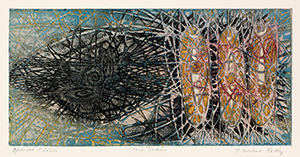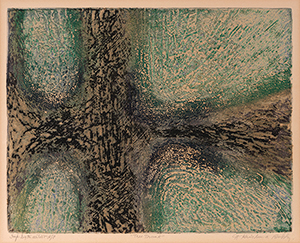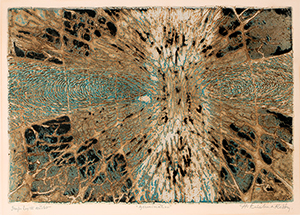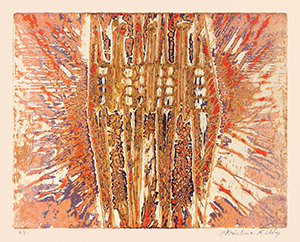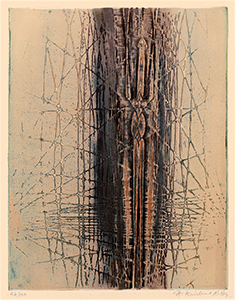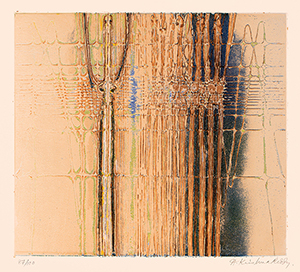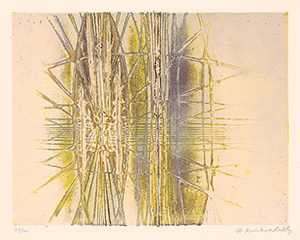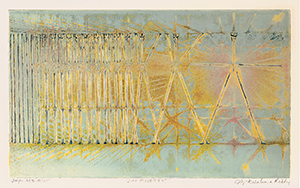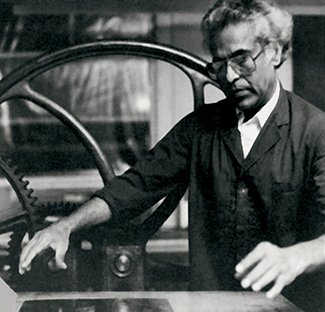
“I have lived to explore a series of plates, experimenting with colour processes. Along with the expressive potentialities of these methods grew I felt the need for developing new techniques of plate-preparation and new ways of applying colours to the plate – ways that are so essential for evolving new images in our art.”
"The very process of working an image is constantly one of discovery."
—Krishna Reddy
"From his early days at Atelier 17, he showed himself to be a most original and inventive artist and within a short time became one of my most valuable collaborators and later my associate in directing the Atelier 17 group, frequently replacing me in my absence. His experiments in our method of simultaneous color printing from a single plate led to the discovery of a very personal and elaborate operation which distinguished his work at that time and to this day from all of the other artists using the simultaneous method.
—Stanley William Hayter, introduction, Krishna Reddy Retrospective, Bronx Museum of Art, 1981
“Krishna's spirituality is his art, his life, and his politics. His ability to invest this totality with the otherworldliness makes each engraved plate a subtle yet intensely satisfying creation.”
—Robert Blackburn, Director, The Printmaking Workshop, New York
“His prints continue to resonate with me through the power of his materiality and the vast fields of space and connectivity that he constructed and left behind.”
—Seher Shah (artist/printmaker), Krishna Reddy—No ordinary Printmaker, Financial Times, March 22, 2021.
Krishna Reddy was an Indian-born artist, printmaker, and educator whose technical innovations and deeply philosophical approach to art helped reshape modern printmaking. Best known as the pioneer of viscosity printing, Reddy combined scientific curiosity with an intensely spiritual vision, creating works of great lyrical abstraction that bridged Eastern thought and Western modernism.
Reddy was born on July 15, 1925, in Nandanoor, near Chittoor in Andhra Pradesh, India. From a young age, he was drawn to both art and philosophy, interests that remained central throughout his career. He studied fine art at Santiniketan, the art school founded by Rabindranath Tagore, where he was influenced by Nandalal Bose and Ramkinkar Baij, both emphasizing the union of craft, tradition, and modernist experimentation.
In 1947, Reddy traveled to London, where he studied sculpture at the Slade School of Fine Art under Henry Moore. He soon began working in Paris, attracted to the international avant-garde community there in the postwar years.
Paris became Reddy’s artistic home from the early 1950s onward. He studied sculpture with Ossip Zadkine and drawing with Fernand Léger, absorbing various styles of modern European art. Most importantly, he joined Atelier 17, the experimental printmaking workshop led by visionary British artist Stanley William Hayter.
At Atelier 17, Reddy collaborated with artists such as Joan Miró, Alberto Giacometti, and Pablo Picasso. It was here that he developed his major contribution to printmaking: viscosity printing. This innovative intaglio technique uses inks of different viscosities and rollers of varying hardness to print multiple colors at once from a single plate. The process produced rich textures, depth, and luminosity, opening new opportunities for abstraction in printmaking.
Reddy’s prints and sculptures reflect his belief in the interconnectedness of all life forms, drawing from Indian philosophy, modern science, and his lifelong interest in cosmology and ecology. His abstract shapes often resemble cellular structures, geological layers, or cosmic landscapes, evoking a sense of both micro and macro universes. Through his work, Reddy aimed to reveal underlying order and unity amid the flux of natural and human experience.
Beyond his art, Reddy was a dedicated teacher who introduced many students to the potential of printmaking. He taught at several institutions, including New York University’s Art Department, where he worked from 1976 until his retirement. His teaching focused on experimentation, technical skill, and cultivating a personal vision.
Reddy exhibited worldwide, with solo and group shows in India, Europe, and the US. His work is included in major museum collections such as the Amon Carter Museum of American Art (Fort Worth), the National Gallery of Art (Washington, DC), the Metropolitan Museum of Art, the Museum of Modern Art (New York), the M+ Museum (Hong Kong), the British Museum (London), the Victoria and Albert Museum (London), the Musée d’Art Moderne de Paris, and the National Gallery of Modern Art (New Delhi), among others.
He received numerous awards, including the Padma Shri, one of India’s highest civilian honors, in 1972. His contributions to printmaking, both technical and aesthetic, gained widespread recognition from artists and critics, establishing him as a prominent figure in 20th-century art.
Krishna Reddy continued to create and teach into his later years. Despite declining health, he remained committed to exploring new visual languages that merged science, spirituality, and art. He died in New York City on August 22, 2018, at age 93. Today, Reddy is remembered not only as a master printmaker and innovator but also as a connector between cultures and disciplines. His legacy endures through the artists he mentored, the institutions that study his work, and the lasting influence of viscosity printing, which expanded printmaking’s possibilities worldwide.
